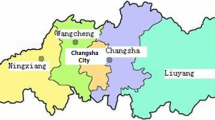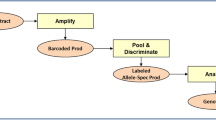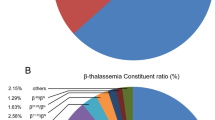Abstract
The objective of this study was to review the prevalence and features of the beta thalassaemia trait in Jamaican populations. Screening of 221,306 newborns over the last 46 years has given an indication of the distribution and prevalence of beta thalassaemia genes, and screening of 16,612 senior school students in Manchester parish, central Jamaica, has provided their haematological features. The prevalence of the beta thalassaemia trait predicted from double heterozygotes was 0.8% of 100,000 babies in Kingston, 0.9% of 121,306 newborns in southwest Jamaica, and 0.9% of school students in Manchester. Mild beta+ thalassaemia variants (-88 C>T, -29 A>G, -90 C>T, polyA T>C) accounted for 75% of Kingston newborns, 76% of newborns in southwest Jamaica, and 89% of Manchester students. Severe beta+ thalassaemia variants were uncommon. Betao thalassaemia variants occurred in 43 patients and resulted from 11 different variants of which the IVSII-849 A>G accounted for 25 (58%) subjects. Red cell indices in IVSII-781 C>G did not differ significantly from HbAA, and this is probably a harmless polymorphism rather than a form of beta+ thalassaemia; the removal of 6 cases in school screening had a minimal effect on the frequency of the beta thalassaemia trait. Red cell indices in the beta+ and betao thalassaemia traits followed established patterns, although both were associated with increased HbF levels. The benign nature of beta+ thalassaemia genes in Jamaica means that cases of sickle cell-beta+ thalassaemia are likely to be overlooked, and important clinical questions such as the role of pneumococcal prophylaxis remain to be answered.

Similar content being viewed by others
References
Betke K, Marti HR, Schlicht I (1959) Estimation of small percentages of foetal haemoglobin. Nature 185:1877–1878
Donaldson A, Old J, Fisher C, Serjeant BE, Serjeant GR (2000) Jamaican Sβ+ thalassaemia: mutations and haematology. Br J Haematol 108:290–294
Giardine BM, Joly P, Pissard S, Wajcman H, Chui DHK, Hardison RC, Patrinos GP (2021) Clinically relevant updates of the HbVar database of human hemoglobin variants and thalassemia mutations. Nucleic Acids Res 49:D1192–D1196. https://doi.org/10.1093/nar/gkaa959
Mason K, Gibson F, Gardner R, Warren L, Fisher D, Happich M, Kulozik A, Hambleton I, Serjeant B, Serjeant G (2016a) Newborn screening for sickle cell disease; Jamaican experience. West Ind Med J 65:18–26. https://doi.org/10.7727/wimj.2015.492
Mason K, Gibson F, Higgs D, Fisher C, Thein SL, Clark B, Kulozik A, Happich M, Serjeant B, Serjeant G (2016b) Haemoglobin variant screening in Jamaica: meeting student’s request. Br J Haematol 172:634–636. https://doi.org/10.1111/bjh.13531
Mason KP, Grandison Y, Hayes RJ, Serjeant BE, Serjeant GR, Vaidya S, Wood WG (1982) Post-natal decline of fetal haemoglobin in homozygous sickle cell disease: relationship to parental HbF levels. Br J Haematol 52:455–463
Merault G, Keclard L, Garin J, Poyart C, Blouquit Y, Arous N, Galacteros F, Feingold J, Rosa J (1986) Hemoglobin La Desirade αA2β2 129 (H7) Ala→Val: a new unstable hemoglobin. Hemoglobin 10:593–605
Millard DP, Mason K, Serjeant BE, Serjeant GR (1977) Comparison of the haematological features of the βo and β+ thalassaemia traits in Jamaican Negroes. Br J Haematol 36:161–170
Serjeant BE, Forbes M, Williams LL, Serjeant GR (1974) Screening cord bloods for detection of sickle cell disease in Jamaica. Clin Chem 20:666–669
Serjeant BE, Mason KP, Serjeant GR (1978) The development of HbA2 in normal Negro infants and in sickle cell disease. Br J Haematol 39:259–265
Serjeant GR (2022) Phenotypic variation in sickle cell disease: the role of beta globin haplotype, alpha thalassemia and fetal hemoglobin in HbSS. Expert Rev Hematol 15:107–116. https://doi.org/10.1080/17474086.2022.2040984
Serjeant GR, Serjeant BE, Forbes M, Hayes RJ, Higgs DR, Lehmann H (1986) Haemoglobin gene frequencies in the Jamaican population: a study of 100,000 newborns. Br J Haematol 64:253–262
Serjeant GR, Serjeant BE, Mason K, Happich M, Kulozik A (2019) Beta thalassemia mutations in Jamaica: geographic variation in small communities. Hemoglobin 42:294–296. https://doi.org/10.1080/03630269.2018.1540354
Serjeant GR, Serjeant BE, Mason KP, Gibson F, Gardner R-A, Warren L, Hambleton IR, Thein SL, Happich M, Kulozik AE (2022) Newborn screening for abnormal haemoglobins in Jamaica: practical issues in an island programme. J Med Screen. https://doi.org/10.1177/09691413221111209
Sweeting I, Serjeant BE, Thomas PW, Serjeant GR (1997) Microchromatographic quantitation of HbA levels in phenotypes of sickle cell-β+ thalassemia. J Chromatogr 700:269–274
Vetter B, Schwarz C, Kohne E, Kulozik AE (1997) Beta-thalassaemia in the immigrant and non-immigrant German populations. Br J Haematol. 97:266–272. https://doi.org/10.1046/j.1365-2141.1997.342674.x
Weatherall DJ, Clegg JB (1981) Thalassaemia syndromes, 3rd edn. Blackwell Scientific Publications, Oxford, UK
World Population Review quoting Statistical Institute of Jamaica 2023. Accessed from internet on 16 Jun 2023
Funding
This work was funded in part by the National Health Fund of Jamaica, grant HPP70.
Author information
Authors and Affiliations
Contributions
GRS and BES conceived the study; KPM, FG, R-A G, GRS, and LW conducted the blood collection and analysis; MR performed the statistical analysis; AEK and MH performed the DNA analyses. All authors read and approved the manuscript.
Corresponding author
Ethics declarations
Ethical approval
The study was approved by the Ministry of Health and the Ministry of Education of the Jamaican Government and performed in accordance with the ethical standards laid down in the 1964 Declaration of Helsinki and its later amendments or comparable ethical standards.
Competing interests
The authors declare no competing interests.
Additional information
Publisher’s note
Springer Nature remains neutral with regard to jurisdictional claims in published maps and institutional affiliations.
Rights and permissions
Springer Nature or its licensor (e.g. a society or other partner) holds exclusive rights to this article under a publishing agreement with the author(s) or other rightsholder(s); author self-archiving of the accepted manuscript version of this article is solely governed by the terms of such publishing agreement and applicable law.
About this article
Cite this article
Serjeant, G., Serjeant, B., Mason, K. et al. The beta thalassaemia trait in Jamaica. J Community Genet 14, 355–360 (2023). https://doi.org/10.1007/s12687-023-00657-9
Received:
Accepted:
Published:
Issue Date:
DOI: https://doi.org/10.1007/s12687-023-00657-9




